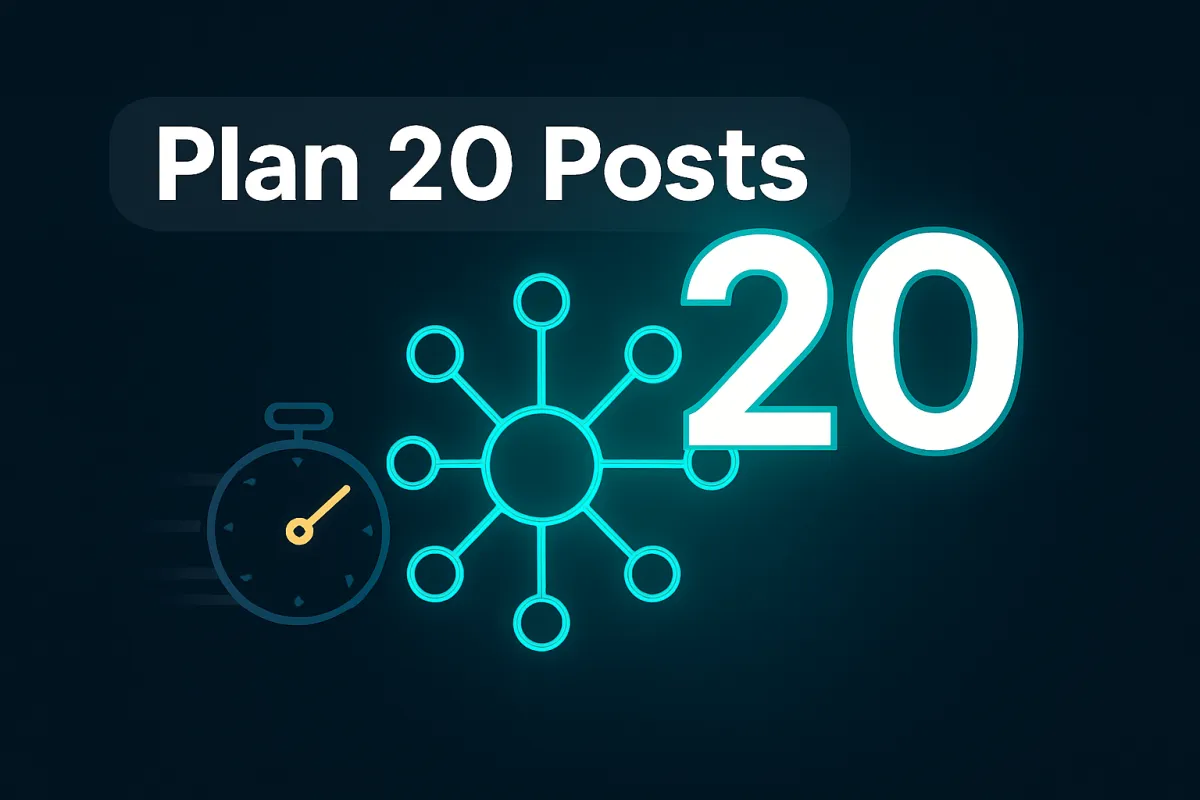ChatGPT SEO Topic Clusters: A Solo Founder’s 2-Hour Workflow for 20 Posts
A hands-on, budget-friendly guide to using ChatGPT for content cluster planning. No pricey tools required.

“I’ve never figured out keyword clusters. It just feels like rewriting the same post with different keywords.”
If that sounds familiar, you are not alone.
As a solo SaaS founder, you do not need a 30-hour content plan or a $200 per month SEO suite. You need something you can execute quickly, repeat without stress, and afford on a bootstrapped budget.
This guide shows how to use ChatGPT to plan a 20-topic SEO cluster in about two hours. You will also learn simple validation steps so you are not guessing.
What are SEO topic clusters, and why they matter
A topic cluster is a pillar page plus supporting posts, all interlinked.
- The pillar is a broad, comprehensive guide.
- The cluster posts cover narrower angles, link to the pillar, and often to each other.
This structure signals topical authority to search engines and gives readers a one-stop resource. See the model explained by HubSpot.
Why use ChatGPT for cluster planning
- Speed: Go from zero to 20 organized topics in under two hours.
- Cost: ~$20 per month for ChatGPT Plus, far cheaper than many SEO suites.
- Simplicity: You do not need dashboards and exports to get a usable plan.
Important caveat: ChatGPT does not pull live search data. It is great for ideation, not for deciding demand or competitiveness. Always validate with quick checks. See Search Engine Journal.
Pro example: SEO lead Tobias Willmann fed Google Search Console queries into ChatGPT and asked it to group thousands of phrases into clusters. What takes hours by hand can be done in minutes. See the overview on Influencer Marketing Hub.
The 2-hour workflow
Step 1. Pick your pillar topic (5–10 minutes)
Choose a broad theme that aligns with your product and audience. It should support 15–20 distinct subtopics.
Examples
|
Product type |
Pillar idea |
|---|---|
|
Email SaaS |
“Email marketing for small businesses” |
|
PM tool |
“Remote team productivity” |
|
Analytics SaaS |
“Product analytics for SaaS” |
Make sure each subtopic would serve your ICP.
Step 2. Prompt ChatGPT for subtopics (15–20 minutes)
Start wide, then narrow. Use clear prompts in ChatGPT.
Prompts you can paste
- “List without description the top 20 subtopics and questions people have about [pillar topic].”
- “Expand each subtopic with 2 specific, non-overlapping blog ideas (titles only).”
- “Add overlooked subtopics related to [area you care about], then merge duplicates and remove overlaps.”
If results are too generic, push for specificity:
- “Focus ideas on B2B SaaS teams under 50 employees.”
- “Prioritize how-to, comparison, checklist, and metrics or measurement angles.”
Step 3. Refine, group, and assign angles (25–30 minutes)
Goal: 20 unique, non-overlapping posts that cover the pillar as a set.
- Dedupe and merge: If two ideas target the same intent, keep the stronger phrasing and merge scope.
- Group into 3–4 themes: Paste your pruned list back into ChatGPT and ask, “Group these into 3–4 thematic clusters with short labels.” Use the result to spot gaps and balance coverage.
- Assign angles and titles: Give each topic a clear format and a compelling title.
Example snippets for a “Remote Team Productivity” pillar
- How to Run Effective Virtual Meetings (how-to)
- Slack vs. Email vs. Teams: Choosing a Communication Stack (comparison)
- Scheduling Hacks for Global Teams Across Time Zones (checklist)
- 7 Metrics That Actually Measure Remote Team Productivity (metrics)
- Trello vs. Asana vs. Monday for Remote Teams (comparison)
Step 4. Validate with quick checks (20–25 minutes)
ChatGPT gives ideas. You decide if they are viable.
- Search volume sanity check: Use Google Keyword Planner or Google Trends. If a phrase has no data, swap in a more common synonym.
- SERP intent check: Google the core phrase. If page one is product pages but you planned a how-to, adjust your angle to match what searchers expect.
- Difficulty sniff test: If page one is full of mega domains, keep the topic if it is foundational, but prioritize easier wins first and differentiate your angle.
SEO Content Briefs in 2025: Solo Founder’s 30-Minute Intent-First Workflow. A natural next step once your cluster is set and you are ready to outline posts quickly.
Step 5. Finalize and schedule (20–25 minutes)
- Pillar format: Create an “Ultimate Guide” that links to all supporting posts.
- Internal link plan:
- Pillar links out to every cluster post.
- Each cluster post links back to the pillar in the intro and to relevant siblings.
- Cadence: Publish the pillar first, then drip supporting posts at a pace you can keep, for example one per week. Track the plan in Notion.
Two tool assists (optional but helpful)
- Draft and brief faster: Use Frase to turn each topic into an SEO-driven outline or draft in minutes. Then add your insights before publishing.
- Organize execution: Map clusters, track status, and manage internal link plans in Notion so you stay consistent.
Frase Review 2025: From Keyword to Rank-Ready Draft in 15 Minutes. See how a dedicated tool compares to a pure ChatGPT workflow for drafting.
DIY vs. paid tools
|
Approach |
Cost and time |
Notes |
|---|---|---|
|
ChatGPT-led planning |
About $20 per month, about 2 hours for 20 topics |
Fast and light with a minimal learning curve |
|
Premium SEO suites |
Typically $100+ per month with steeper learning curves |
Great at scale, heavy for solos early on |
|
Limitation to remember |
ChatGPT cannot show live search volume or competition |
Always validate ideas with quick checks (Search Engine Journal) |
Generative Engine Optimization (GEO): The New SEO You Can Buy on Fiverr in 2025. A useful contrast if you are considering pre-packaged “AI SEO” services instead of building your own durable cluster.
Case study: how clustering compounds traffic
SEO strategist Samuel Schmitt reorganized content into a topic cluster and reported a 100× increase in organic traffic over time. Read the breakdown on Thruuu.
The takeaway for founders is simple. When you cover a topic well and interlink pillar and cluster posts, the whole is greater than the parts.
Pair that proven structure with AI-assisted speed, and you can punch above your weight. See HubSpot’s model for background.
Common pitfalls to avoid
- Publishing overlapping posts that target the same intent. Merge duplicates before you write.
- Skipping validation. AI ideas still need volume and intent checks (Search Engine Journal).
- Choosing topics your ICP does not care about. Tie every post back to product value.
Copy-paste prompt pack
- “List without description the top 20 subtopics and questions for [pillar topic] targeting [audience].”
- “Expand each subtopic with 2 unique, non-overlapping blog titles. Mix formats (how-to, checklist, metrics, comparison, case).”
- “Remove duplicates and combine overlapping intents. Return 20 unique topics.”
- “Group the 20 into 3–4 thematic clusters with short labels.”
- “Assign a distinct angle and working title to each topic. No overlap.”
Wrap-up
In about two hours, you can move from “I do not know where to start” to a validated, 20-topic SEO cluster mapped to a pillar page.
- Use ChatGPT for speed and structure.
- Validate with intent and demand checks.
- Publish on a realistic cadence. Track your plan in Notion and speed up outlines and drafts with Frase. Add your own expertise and examples to make each post genuinely helpful.
Stay consistent and your cluster becomes an engine. You build topical authority, strengthen internal links, and see compounding organic traffic over time. That is what a bootstrapped SaaS needs.





